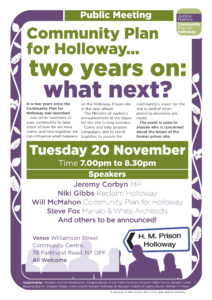The consultation period ends on 24 July. The Women’s Building Working Group urges organisations and individuals to send their responses to the Draft Brief before then, to the planner in charge, Linda Aitken, at linda.aitken@islington.gov.uk.
The draft and its two appendices can be downloaded here:
www.islington.gov.uk/consultations/2020/draft-consultative-development-brief
Below are bullet points setting out the position of the Women’s Building Working Group on the questions in the Draft Brief and some of its sections. If you agree us and wish to make similar points, we hope you will put them in your own words. You don’t need to copy the questions in your response.
Please begin your response by identifying yourself and any group or neighbourhood that you represent.
————————————————————————
Consultation to date (page 2)
- In the 14 months since the sale of the prison to Peabody, neither Peabody nor the Council to date have attempted a real public consultation.
- The organizations listed as having been consulted for the Brief are heavily skewed to towards those connected to the criminal justice system.
- Reclaim Holloway, Hibiscus and Treasures were not formally consulted, though they appear on the list.
- Voluntary and community sector (VCS) groups, local community centres, and ethnic/religious/cultural organizations were largely ignored.
- The Mayor’s Office for Policing and Crime (MOPAC) has clearly had a strong influence on the Brief, and aims to play a major role in Building’s future. We oppose this level of involvement by MOPAC. “Policing” and “Crime” are not words that should be associated with a Women’s Building.
- We would welcome the involvement of City Hall through other departments, such as Community Engagement team or the London Legacy Development Corporation.
- Best practice would be to publish the detail of consultation activities undertaken, questions being asked in consultation, and job roles of people consulted.
- There has been no discussion of selection processes for the organisation that will manage the building. It is crucial that women-centred and women-led governance structures be fully explored and implemented as soon as possible.
Section One – Who is the Building for? (page 3)
- This section reveals that Council and MOPAC intend to make a criminal justice system-oriented women’s centre the core of the proposed building. We oppose this orientation completely.
- The section refers to an “emerging consensus” about this division within the building, but we reject the statement. There can be no consensus without a properly designed, widespread consultation.
Question One: Do you agree with the proposal that the building should accommodate a women’s centre that will support women in the criminal justice system and women who are at risk of entering the criminal justice system alongside a wider ranging package of services and facilities for women contained within a women’s building?
- There should be no separate women’s centre within the Women’s Building.
- Segregating spaces and services in this way will inevitably be stigmatizing.
- Inclusivity of the building and its services, rooms and amenities is central to our vision of the site.
- Services in the Women’s Building should be available to all women who need them, not just those directly affected by the criminal justice system.
- While specialist services should be offered that can help women who are directly affected by the criminal justice system, any other women who can benefit from them should be able to access them.
Question Two: Do you think that all of the building should be for women only or do you think that all members of the community including men should be allowed to use some of the building?
- Whether and how much of the building is accessible to men should be decided at a later date by the body that eventually runs the Women’s Building.
- The Building should have women-only spaces designated for activities that require an extra degree of safety and of sensitivity to women’s concerns and needs.
- Women-only spaces will be inclusive of all women, trans, intersex and non-binary people, those with disabilities, and of all ethnicities and faiths.
Question Three: Do you agree with the proposal that the women’s centre that […] should be located in the more private parts of the building with these more private areas being provided alongside more publicly facing areas that will facilitate a more wide ranging package of services and facilities to all women?
- There will clearly be a need for quiet, safe and private places within the Building for the provision of advice, therapy and support.
- All women, not just those caught up in the criminal justice system, should be able to access these spaces.
- The Women’s Building must provide an alternative to the criminal justice system. Separating a women’s building (for everyone) and a women’s centre (for women in the criminal justice system) limits the holistic function of the Building, risks attaching stigma to those accessing women’s centre services, and prioritises criminal justice rather than community services.
Question Four: Do you agree with the overarching design principles that the council has established for the building? And Question Five: Has the council failed to identify any key design principles that should be incorporated into the brief for the building?
- The Women’s Building has always been envisioned as freestanding – not part of a residential block, as the draft proposes – and architecturally distinctive.
- The Women’s Building cannot be a distinctive landmark if it is designed as merely a part of a residential block.
- The design principles are completely vague about how the social history of HMP Holloway will be reflected in the architecture.
- The Brief’s focus on design with women-only services in mind minimizes the legacy role of the Women’s Building, and indeed the entire site. History and commemoration should be at the heart of the development, reflected not only in the Women’s Building’s commercial and community spaces but throughout the site.
- We agree with some of the principles: a celebratory and public presence; a main entrance close to public transport links as well as additional safe and discrete secondary access; be ‘trauma informed’ and include a range of open, public spaces and more private spaces; the Building should conform to the highest standards of accessibility and sustainability.
Question Six: Does this DRAFT brief identify all the space requirements for the building? Is there anything that we have missed?And Question Seven: Do you have any thoughts about the proposed sizes of the different elements of the building as outlined above?
- It is impossible to answer Questions 6 and 7 at the moment. A properly funded Feasibility Study and a real public consultation should be carried out first.
- Provision should be made for a museum or exhibition centre commemorating the site’s history.
Question Nine (there is no question 8): What can the council do to ensure that the physical layout of the building facilitates a sustainable funding model for its future operators
- As with Questions 6 and 7, this question cannot be answered until a Feasibility Study and public consultation should be carried out first.
- The Brief says on page 9 that “Together with MOPAC and other expert bodies, women’s organisations, and local community groups, the council will develop a service specification for the building.” MOPAC is not an expert body in this area, and there is no reason for it to be so deeply involved in creating the specifications.
Section Six – Commissioning Architects (page 9)
- It is essential to the concept of the Women’s Building that the architects be chosen through a transparent competition for women-led architectural practices.
- Peabody was initially open to this, and there is no convincing reason why it should change its position.
- The Brief should state that a majority of the tradespeople working on the Building, and indeed on the whole prison re-development will be women.
Question Ten: What do you think of these examples [of buildings shown in Appendix 2]? Can you think of any other examples of best practice?
- While it contains many attractive examples of contemporary architecture, we do not believe that this appendix is useful at this stage of the consultation.
The CP4H Women’s Building Working Group is made up of local residents, activist groups and women’s service providers who have been campaigning for a Women’s Building since the prison closed. It’s thanks to them that the council have mandated a Women’s Building be built on the site.
To join the group email plan4holloway@gmail.com.
See their Vision Document below to get an idea of what they are calling for




